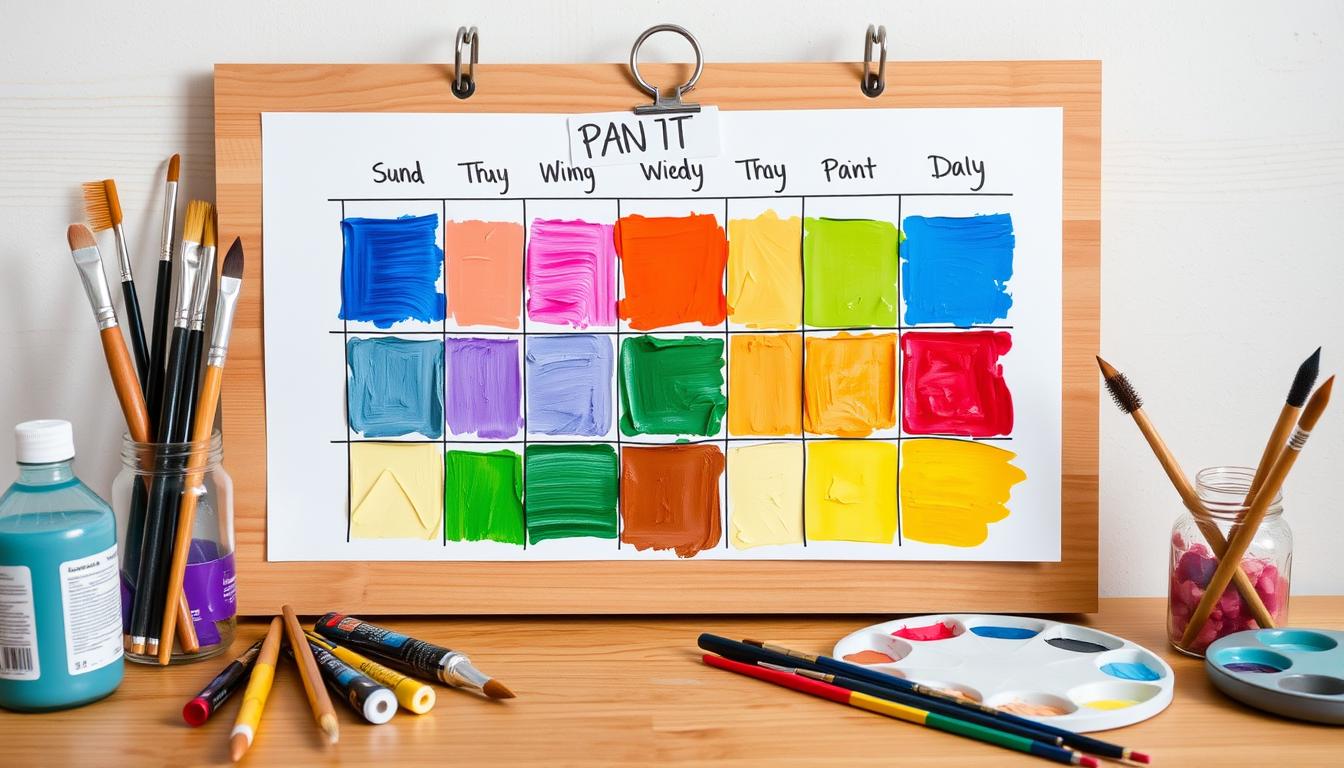Creating an efficient paint schedule is vital for any painting project’s success. A well-planned schedule ensures timely completion, stays within budget, and meets quality standards. Effective time management and project planning are key to a successful painting project.
By focusing on time management and project planning, you can prevent delays and cost overruns. A structured paint schedule guides you from preparation to completion. It keeps you organized and focused on your objectives.
With a clear plan, your painting project will be completed efficiently and effectively. This approach saves time, money, and reduces stress. In this article, we’ll discuss the importance of project planning and provide a step-by-step guide to creating an efficient paint schedule.
Key Takeaways
- Effective time management is essential for a successful painting project
- Project planning helps avoid delays and cost overruns
- A well-structured paint schedule guides you through the entire process
- Prioritizing time management and project planning reduces stress and anxiety
- A clear plan in place saves time and money
- Efficient paint schedules ensure projects are completed to the desired quality
Understanding the Importance of a Paint Schedule
A well-structured paint schedule is crucial for a successful painting project. It ensures tasks are completed in a logical and efficient order. This approach saves time and reduces costs. Effective project planning is key to achieving an efficient workflow. Thus, a paint schedule is a vital tool for any painting project.
Having a clear plan avoids delays, reduces waste, and ensures timely completion within budget. A paint schedule outlines the painting process steps, from preparation to completion. It keeps you organized and focused throughout the project.
- Improved time management
- Increased efficiency
- Reduced costs
- Enhanced quality control
By integrating project planning and efficient workflow into your paint schedule, you can ensure a successful painting project. This is true for both professional painters and DIY enthusiasts. A well-structured paint schedule is essential for achieving professional-looking results.
Essential Tools and Materials for Project Success
To ensure an efficient workflow in your painting project, having the right tools and materials is crucial. This includes high-quality paint, various brushes, rollers, and drop cloths. These essentials save time and effort, leading to a smooth and successful project.
Room preparation is a key aspect of a successful painting project. It involves cleaning, sanding, and priming surfaces to be painted. Proper preparation is essential for a professional finish and paint adhesion. Investing time in preparation avoids costly rework and ensures a durable paint job.
- Paint trays and liners
- Paint rollers and extension poles
- Sandpaper and power sanders
- Drop cloths and tarps
- Masking tape and paper
With these tools and materials, you’ll be ready to tackle your painting project confidently. Always follow safety guidelines and best practices when working with paint and materials. This ensures a safe and successful project.
Assessing Your Paint Project Scope
Understanding the scope of your painting project is essential for an efficient project timeline. This involves several key steps. First, measure the area to be painted. Then, determine the paint amount needed. Lastly, identify any special surface considerations that may affect your room preparation.
To begin, measure the square footage of the area to be painted. This step helps you figure out how much paint to buy and how to plan your time. Use a tape measure to find the length and width of each wall, ceiling, and floor. Then, multiply these numbers to calculate the total square footage.
Next, determine the paint amount required for your project. This depends on the surface type, color, and finish. Generally, one gallon of paint covers about 350-400 square feet. But, this can vary based on the product and application method. Always check the manufacturer’s instructions for accurate information.
Lastly, consider any special surface considerations that may impact your project. This includes trim work, molding, and ceilings with unique textures or finishes. By carefully assessing your project scope and planning, you can ensure a smooth and successful painting experience.
| Surface Type | Paint Requirements |
|---|---|
| Walls | 1 gallon per 350-400 square feet |
| Ceilings | 1 gallon per 400-450 square feet |
| Floors | 1 gallon per 300-350 square feet |
Creating Your Detailed Paint Schedule
To ensure a successful painting project, it’s essential to create a detailed paint schedule. This involves developing a project timeline that outlines all the tasks and activities involved in the project. A well-planned painting sequence can help you stay organized and on track, ensuring that your project is completed efficiently and effectively.
When creating your paint schedule, consider the following key elements:
- Assessing the scope of the project and identifying all the tasks involved
- Allocating resources, such as labor, materials, and equipment
- Setting milestones and deadlines to track progress and stay on schedule
A well-structured paint schedule can help you avoid delays, reduce costs, and ensure a high-quality finish. By following a logical painting sequence, you can ensure that each task is completed in the right order, and that your project stays on track. Remember to regularly review and update your project timeline to ensure that you’re meeting your deadlines and staying on schedule.
By creating a detailed paint schedule, you can ensure a successful and stress-free painting project. With a clear project timeline and a well-planned painting sequence, you can achieve a professional-looking finish and enjoy your newly painted space.
| Task | Deadline | Resources |
|---|---|---|
| Prepare surface | Day 1 | Sandpaper, primer |
| Apply first coat | Day 2 | Paint, brushes |
| Apply second coat | Day 3 | Paint, brushes |
Room Preparation Sequence
To achieve an efficient workflow in your painting project, it’s crucial to establish a well-planned room preparation sequence. This involves a series of steps that ensure each room is properly prepared before painting begins. A key part of this process is understanding the painting sequence and how it impacts the overall efficiency of your project.
When preparing a room for painting, consider the following key steps:
- Cleaning the room to remove dirt, grime, and grease
- Sanding surfaces to create a smooth finish
- Priming walls to ensure better paint adhesion and coverage
These steps are essential for creating a strong foundation for your paint job and ensuring a professional-looking finish. By incorporating these steps into your painting sequence, you can optimize your workflow and minimize downtime.
Efficient workflow is critical in a painting project, as it directly affects the project’s timeline and budget. By streamlining your room preparation sequence and painting sequence, you can complete your project on time and within budget. Proper planning and execution are key to achieving a successful painting project.
By following these guidelines and establishing a well-planned room preparation sequence, you can ensure a smooth and efficient painting process. Remember to always prioritize efficient workflow and a well-structured painting sequence to achieve the best results for your project.
Establishing the Optimal Painting Order
The order in which you paint significantly affects the project’s success. A well-thought-out painting sequence ensures timely completion and high-quality results. Effective time management is key, allowing painters to work efficiently and maximize their time.
Several factors influence the optimal painting order. These include interior vs exterior considerations, weather and temperature, and coordinating multiple rooms. For example, exterior painting should be done in favorable weather, while interior painting can occur at any time. By considering these elements, painters can avoid delays and maintain a smooth workflow.
Interior vs Exterior Considerations
Interior and exterior painting present unique challenges. Interior painting requires careful planning to minimize disruptions, whereas exterior painting is weather-dependent. A well-planned order addresses these differences, ensuring efficient and effective completion.
Weather and Temperature Factors
Weather and temperature are crucial for painting. Paint dries best in temperatures between 60-80°F, and high humidity slows drying. By factoring these conditions into the painting order, painters can achieve optimal drying and quality.
Multiple Room Coordination
Painting multiple rooms requires careful coordination to avoid disruptions and stay on schedule. A well-organized painting order considers traffic flow, furniture and fixture locations, and the space’s layout. This approach ensures an efficient, effective painting process with minimal downtime.
Time Management Strategies for Painters
Effective time management is key for painters to meet project deadlines and quality standards. By prioritizing tasks and managing workflow, painters can reduce downtime and boost productivity. Project planning is vital in this process, helping painters stay organized and focused on their objectives.
To excel in time management, painters should consider these strategies:
- Divide big tasks into smaller, more manageable pieces
- Set a schedule and adhere to it
- Reduce distractions and concentrate on the task at hand
By adopting these methods, painters can enhance their time management abilities and deliver outstanding results. Effective project planning also aids in anticipating and preparing for potential hurdles. This ensures projects are completed on time and within budget.
Combining adept time management and project planning skills can elevate a painter’s business. It helps establish a reputation for reliability and quality.
Managing Multiple Paint Types and Drying Times
Managing multiple paint types and drying times is key for an efficient workflow in painting projects. This requires careful planning and understanding various factors. These include the paint type, surface preparation, and environmental conditions. By planning your project well, you can keep it on schedule and achieve a high standard.
To manage this effectively, consider the following:
- Paint type scheduling: Choose the right paint for the job and plan its application for proper drying.
- Ventilation planning: Good ventilation is crucial for paint to dry quickly and evenly.
- Weather impact management: Weather, such as temperature and humidity, greatly affects paint drying times.
By accounting for these factors in your project planning, you can streamline your workflow. This ensures your painting project is finished on time and to a high standard.
| Paint Type | Drying Time | Ventilation Requirements |
|---|---|---|
| Latex | 1-2 hours | Good ventilation |
| Oil-based | 2-4 hours | Excellent ventilation |
| Acrylic | 30 minutes-1 hour | Fair ventilation |
By adhering to these guidelines and integrating project planning into your workflow, you can ensure a smooth and successful painting project. The result will be a high-quality finish.
Quality Control Checkpoints
Incorporating quality control checkpoints into project planning is crucial. It ensures the painting project meets the desired standards. An efficient workflow allows for regular inspections and touch-ups. This approach helps painters identify and address issues promptly, saving time and resources.
Regular surface inspections are key. A schedule should outline specific inspection points. For example, after preparing the surface, applying the first coat, and after the final coat. Following this schedule ensures any imperfections are caught and fixed, leading to a high-quality finish.
Surface Inspection Timing
Timing is everything when it comes to surface inspections. Painters should inspect the surface after each coat. They can use a checklist to ensure thoroughness. The checklist might include:
- Checking for any dust or debris on the surface
- Inspecting the surface for any imperfections or scratches
- Verifying that the paint is evenly applied and there are no streaks or marks
Touch-up Planning
Touch-up planning is vital for quality control. Painters should plan for touch-ups after the final coat. This allows for any necessary repairs or adjustments. It includes touching up areas where paint may have gotten on surrounding surfaces, like trim or flooring. Proper planning ensures the final result is of high quality.
By adding quality control checkpoints to project planning, painters can achieve efficient and effective results. This involves creating a schedule, conducting regular inspections, and planning for touch-ups. These steps contribute to a smooth workflow and successful project planning.
Conclusion: Implementing Your Paint Schedule for Project Success
By following the comprehensive steps outlined in this article, you now have the tools to create and implement an efficient paint schedule for your upcoming project. Time management and project planning are crucial. They ensure your painting job is completed on time, within budget, and to the desired quality.
A well-structured paint schedule allows you to allocate resources effectively. It coordinates tasks and proactively addresses any challenges that may arise. With careful preparation and attention to detail, you can transform your painting project into a seamless and successful endeavor.
Take the insights gained from this guide and apply them to your own painting venture. By prioritizing a strategic approach, you’ll be able to save time, reduce costs, and deliver a stunning final result. This result will exceed your client’s expectations.






